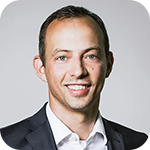Andreas Rohr: The most convincing story for works council who were actually not there to prevent security or the company doing the right things, they're there to make sure that the data is not abused against the employee's rights. It's their mission, their task, and it's a valid one. When I was in a CISO position in such companies where there were actually a strong works council, the best relationship is if you're really being transparent to what you do, why you're doing that?
Speaker 2: Hello, and welcome to Security Visionaries. You just heard from today's guest, Andreas Rohr, CTO at DCSO. Aligning organizations on security requires many skills, most importantly, transparency. From establishing top-down communication to collaborating with work councils, transparency answers many questions along the way. Like, who has access to the sensitive information? What is an organization's appetite for risk? And how is the data of employees protected? Before we dive into Andreas's interview, here's a brief word from our sponsor. This Security Visionaries podcast is powered by the team at Netskope. At Netskope, we are redefining cloud, data and network security with a platform that provides optimized access and zero trust security for people, devices, and data anywhere they go. To learn more about how Netskope helps customers be ready for anything on their sassy journey, visit N-E-T-S-K-O-P-E.com. Without further ado, please enjoy episode 20 of Security Visionaries with Andreas Rohr, CTO at DCSO and your host, Mike Anderson.
Mike Anderson: Welcome to today's episode of Security Visionaries. I'm your host, Mike Anderson. I'm the Chief Digital and Information Officer here at Netskcope. Today, we are joined by Andreas Rohr who's joining us from Germany. How are you doing today, Andreas?
Andreas Rohr: Oh, very good. Thanks for pronouncing the name very nicely.
Mike Anderson: I'm super excited about this conversation today because when we think about cyber security, you've done some very interesting things around bringing people together in the DACH region and thinking about companies of all sizes as you think about the cyber topic. And so can you tell us more about DCSO, how it started, the mission you've got, what you're trying to accomplish and how you're working with companies?
Andreas Rohr: So DCSO stands for German Cyber Security Organization. So the D is for Deutsche, for those that are maybe familiar with the language. And what basically four companies in the DACH region; Allianz, BASF, Volkswagen and Bayer, you might have heard of, some of the largest companies in Europe, they saw that they should basically combine forces and get exchanging ideas with other peers of themselves to not reinvent always the security topics by themselves and bringing together their experts. Because they have one thing in common, which is 90%, 80% of what they're challenging and security is more or less the same despite that they're competing on the market. And second, the talents are not enough on the market. So bringing them together under one roof and tasking them with things they're all interested in, would make things even better. And resource enabled testing of new ideas. So this is one of the things. The second one is they all have their supply chain they're dependent on. And this was seven years ago, so supply chain attack as a term was not born back then, but they already realized that the weakest link basically is not their secure and their security team and the maturity of them, but their supply chain ones, which are most dependent on.
Andreas Rohr: And digesting or making things in a way digestible from their security insights and learnings, is what DCSO as a community-driven exchange to operationalize such insights and technology as what we also have been founded for, to find ways to make it easier to use and also to apply for those companies that do not have a huge security team or even any knowledge. So operationalizing with security services was the second task, basically during the foundation of the company.
Mike Anderson: No, that's great. And I definitely know that we've got so many open cyber roles out there today. Anything you can do to help companies combat the bad actors that are out there that wanna cause harm to companies. As you said, these are competitors in some cases coming together at the table to figure out how they can basically protect ourselves from the adversaries that live out there in the wild. So it's definitely a strong mission. Have you had other companies that have joined in as part of that? And you've talked about the four that joined originally, but have you had more that have joined in that mission as well?
Andreas Rohr: So that's a good question. So that's not only the four. We very early started this with around 16 of tax companies we're now about 20, 21 or so of like and a few family owned and likewise and size companies. And they basically steer DCSO's kind of development of the portfolio and what we should talk about and what you should research in terms of topics and directions and help us, in an advisory also so to speak, where to develop into. And the second one is what we also like to and actually achieve to implement is a very regular format where they learn not only with new topics, but also the existing things where they failed or how they solved certain challenges and what did not work out. So that's even more important to shortcut learning curves. And this is not only for the less mature companies, it's also amongst the mature ones. And this proves that bringing folks together, despite their competing on a market, actually useful, effective, and should not only be limited to the companies itself, but also to the relationship for authorities and maybe even also for these research institutes. So really bridging the different fields of expertise and insights, especially to also intelligence services. Makes sense in both ways to have a flow, to not make that visible to the takers or adversaries, as you said.
Mike Anderson: I definitely feel that need for that private-public partnership around exchange of intelligence and what's going on from a threat standpoint. Again, it kinda brings this whole concept that security is a team sport. It's not just the four walls of my organization, but it's the whole ecosystem working together. When you look at that, I'm just curious, when you think about the authorities that are out there, have you been able to influence policy or changes that would help companies have better guideposts or things to align to?
Andreas Rohr: Yep, definitely. That was one of the things which I basically learned from the States. So I've seen the NCFTA, where the FBI and other law enforcement and industry was working together. I think as the early years, in the zero days of 2000s and also other formats for which something that's state-driven. But in general, I like the idea a lot that there's a fluent relationship where the necessary things to help each other is actually exchanged. And this drove also my way of influencing how we do that, and in fact, we have a very good relationship to the Ministry of Interior who actually is responsible for being the advisory function and the supervision of the federal police of the BSI, the federal office for information security, and also the one who's protecting the constitution. Not sure what that translates to English. So having those authorities that have all their own insights from [0:07:13.7] ____, from their peers at the FBI for instance, or from other law enforcement or intelligence services, and making sure it's getting passed on via DCSO as a trusted clearinghouse if you want to, where they can trust this will not leak to the public, especially to the attackers.
Andreas Rohr: But helping companies to find certain things where they have no clear indication that a particular company is threatened by a particular actor. But in general and helping to identify if those attackers are active in those networks, has proven to be very valuable because we've helped also the authorities to find out that a particular group was active by us operationalizing the information they gave us in a trusted way. And we could basically tell them back, "Okay, look, this thing you gave us, we have no idea where it came from, but we have seen that here." And so we help the law enforcement and also the intelligence services to have their targets to be better monitored when they have no sensors, because on the domestic side, the authorities are limited to what they can do in contrast to outside of Germany. And the same thing on the other hand, companies who are sometimes maybe very conservative on letting authorities look into their networks could use us to make sure there's only those things that are actually necessary to fulfill to each individual mission is passed on. And having basically us as a bridge to also cover then not always giving trust in the beginning.
Andreas Rohr: So it's developed into something where there's a more trustworthy exchange where those initial fears, they have not vanished, but they're definitely lower than before. So this helps in the end everyone. Not getting pathetic here, but also helping to get a better protection of the democracy itself where you have influencing parties out there.
Mike Anderson: Well, it sounds like you said lack of no trust, so it sounds like zero trust. So it seems like that's a common theme everywhere. I see a lot of organizations trying to align to it. Look at guidepost, like in the US and even beyond, sometimes we see people aligning to the NIST controls that are out there because the insurance companies which; that'll be a topic we'll talk about a little bit later, they're using that as a guidepost. Auditors use it as a guidepost. What do you see as the guidepost for companies that you're working with today? What is that guidepost that they're trying to align to?
Andreas Rohr: So it's not so much NIST-driven, that's just treated in nature that we are in Europe and trying to sometimes, invent the wheel ourselves instead of putting our forces together. But anyhow, so the guidepost here is more the ISO 27000 or something which is similar to it. It's a very German version of it. They all try to go after making sure that you manage your security correctly. And even more in this, the developer of the last years, the maturity level of those control implementations matters more than the actual compliance of it. So think of having compliance things first and then maybe 10 years ago where they started to implement those things, the effectiveness of that is what matters. So there's actually a shift, and what I like with the NIST and also other frameworks, is that they try to get more into the direction, how effective are you actually protecting yourselves and not necessarily only are you managing basically your risks and having controls. And this is where actually things should develop further into. So compliance is needed, but it's only a necessary condition, its not a sufficient one, 'cause a sufficient one is being effective. And effective actually matters more than the full compliance. But this might be not be cited to a regulator, please.
Mike Anderson: Well, it's interesting, 'cause what I see a lot of times is people will acquire tools because the auditors say you need to have the tool. But as you said, the effectiveness is actually, are you using the tool to accomplish the objective that you want to accomplish or drive the business outcome? And a lot of times that's a missing link because people collect tools to satisfy auditors, but they're not getting the effectiveness they need. And so they're now exposing themselves for business disruption from whether it's ransomware, they're exposing themselves to a data breach in their organization.
Andreas Rohr: Yeah. That's something really that the auditors and the regulators should think differently maybe in future because they drive this development by how they put their regulation. And there's a good change, which I saw was a local security guideline that actually became effective or will get effective fully in 1st of May in Germany, which indicates that you need to have... Like in the ISO 27000 new version, that you need to have systems for detecting attacks. That's what they call it. So basically, ISO detection mechanisms and also response. And this is really the things which you also refer to. It's not only a tool thing, they also mandate that you organizationally need to make sure that you are able to analyze those things, in a human and making sense of that, whether that's something serious to go after or not. And then even more important, being able and having things implemented to react. So it's also organizational-driven thing that you need to have 24/7 ability to, to do something about. If there's an indication of a ransomware group being at an early stage. Because you might only have a few hours or at max, days left to prevent the max damage.
Andreas Rohr: And having these organizational things on top of the tooling and the integration and making use of that in an effective manner is where the regulation should... Like insurance companies actually do, they'll rather look for whether something is effectively secure or not. And this is where it actually needs to develop into. But the regulator, for them it's easier to say you need to have a SIM, you need to have a network detection monitoring. So if you have an own data center and what not. But in the end it might be a good advice also to the regulator, maybe that's one of the next missions of DCSO to influence that to be more practically relevant what they actually tell them. And there's a good example for the national security law that was released two years ago in Germany.
Mike Anderson: No, that's great. You mentioned about managing the impact. I remember a peer of mine at a global consumer package goods company said that when NotPetya hit, it infected their entire network and all their systems within 15 minutes, globally. And so I think that thinking is the traditional, "How do I get things as quickly as possible from point A to point B, to C to D, and around my corporate network." That whole thing has to be rethought because then if I get compromised in one node, can it quickly just take over my entire network and bring my entire business down?
Andreas Rohr: Exactly. And when you also search on that matter, think about, this NotPetya was something which most of the folks could have prevented by doing more hygiene on their patching. But before those things happening, at least with ransomware vectors, they make some noise in the network. So there's almost 100% of the cases which we have been involved, doing incident response, we saw enough signals that could have been basically analyzed and triggered action to stop the attack. It would not necessarily make them to remediate those systems and building things from scratch, but they could have prevented the entire damage that actually happened after a few days. And the same thing is also with NotPetya, if you could have patched those things that are known or have been known to be critical, and a few other good practices that actually mandated in those standards, you have mentioned earlier, then this is the homework, the necessary condition. And the sufficient one is to build on top of that a good net of detection that actually gives you the trigger to act. And, not sure whether it would've been worked out in 15 minutes, but in general there is a timeframe which is shrinking to be fair.
Andreas Rohr: But there's a timeframe where you could detect things and can assume that that not all protective measures will always 100% protect you. And it's either being a user click on something or you have not patched or there's unsecure configuration or whatever in there. But if you assume that's the case and you have a detection grid on top of it, that will tell you, "Okay, there's something you don't want to have here. Please have a look and take action." Maybe even in a very automated or predefined way to stop such attacks is what needs to be done for really good companies in terms of security state.
Mike Anderson: Yeah, I fully agree man. If it's manual, you're always depending on the person in the chair and with a skill gap that can become problematic. So exactly to your point, the automation. So I can take preventative measures and run my play as quickly as possible is critical. Going back on thinking about the security side, and I think about data privacy, everyone talks about GDPR. I always remind people, you think GDPR is tough, wait till you have to go in front of German worker council and talk about data privacy for German citizens. When you think about a lot of security tools, you're inspecting what people are doing. How are you helping companies navigate the German worker council to make sure that they can get the right protections in place, but also preserve the privacy of German citizens?
Andreas Rohr: That's a tricky question. There's no silver bullet to making this happen. That works council is happy with what's happening when massive amount of data is inspected, which is needed for detection, to be fair. But the most convincing story for works council who are actually not there to prevent security or the company doing the right things, they're there to make sure that the data is not abused against their employees. It's their mission, their task, and it's a valid one. And to get along with works councils... And when I was in a CISO position in such companies where there were actually a strong works council, the best relationship is if you are really being transparent to what you do, why you're doing that. So I was pretty young back then. I was not really good in arguing potentially, basically on their mission because they're also having the mission to protect the employees from harm. And this also includes cyber attacks or violations of data privacy and breaches, et cetera. So back then I should have argued, what I do now, that helping to prevent attacks by inspecting some traffic or acquiring certain data would've been the right avenue to go. And that's one of the things which they cannot deny if you know how the constitution basically works.
Andreas Rohr: If you tell them the only use case to use this data, where it's valid to use the data, is for detecting malicious activities and not tracking employees and whatnot, and if you give that in writing, that this is what you do and if you adhere to your own rules for that sense, then they basically will in the first place, put some stones in your way and see whether you behave or not. But if you do that constantly that way that you're only using it for detecting malicious things and by that preventing basically their constituents if you want to, then the next time let you easier pass the door than than before. At least I never failed with getting things through the works council. It's just the way how you put that and that you really adhere to most principles to not use the data for something else that you acquire them for.
Mike Anderson: That's great. Well, hopefully, that's a product line offering that you're offering it at DCSO.
Andreas Rohr: Whenever you buy managed services from DCSO, this is included. So we help the customer to get through the door of the works council and I guess we have a pretty good reputation. And since I've worked with works councils before in the Volkswagen world, but also in the utility where they have really strong works council and tell from my past with them and how good the relationship et cetera, then that's the other part of the story. So we bring our experience in and they like that typically and make their life easier in terms of helping them to argue with their folks. And then it's a matter of trust in the end, not like zero trust, it's really the other way around. So if you build a trust then you can do most things with the works council. And even if you give them just a small hint, a read-only account to the technology you are deploying, this also helps a lot. So they're left to have transparency and helping them to see what you're looking at and what you make out of that and how you comment cases, et cetera, this is also helping to build trust. So they might not grasp everything as they see, but this is where they do not have the feeling there's something in the dark that's happening, which might harm my people. And it's not a secret success ingredient, but it's something which if you adhere to it, that actually will get you likely to a good outcome.
Mike Anderson: That's great. I 100% agree with, transparency is what builds trust. When people don't have transparency, people are guessing and guessing doesn't lead to trust. And so that's a great advice there when dealing with German Worker Council, and just generally as a business principle. Transparency is what builds trust. If I look at the role you have today, and you talked about some of your roles, what are some of the learnings you brought into DCSO? You mentioned that you were a CISO in the past, and now the CTO for DCSO. Talk a little bit about that journey and how have things evolved in your thinking as you've transitioned into the role you have today versus more the practitioner and CISO type roles you had in the past?
Andreas Rohr: When I was CISO back then, I had the same challenge as most CISOs that also have technical teams. So I had a fortune to not only be responsible for the governance and the security management system, but also having an own operational security team and the luxury to play around with technology, et cetera. So what I started most was what that I had all those tools in place that does island wise an okay or even a nice job, but there was no coherent way of utilizing that for an entire picture. And I don't want to say single pane of glass things. So I mean this is often used, but making use of the strengths of the different technologies and combining them is what basically made me successful to be very cost efficient in getting actually the entire value out of the different technology I was employing. And also got my team back then in a position to do some nice things that have been not average to what teams can achieve. So taking this, like, a set of or different tools, an army knife, if you want to, a swiss army knife, then the team that's operating that knife actually matters most. So getting them to deal with different types of input technologies, streams, insights, and operationalizing the different capabilities and skills of the people to maximize the outcome and also helping to solve certain homework for our clients in DCSO, is what drove me when we developed the portfolio.
Andreas Rohr: So one of the things I didn't mention earlier was that I have been also tasked to come up with a managed security service portfolio seven years ago. So put yourself back to that time, there was not very common, having maybe an outsourced SARC or so, but not outsourced managed security services so much and solving homework to those organizations so they can focus on the most interesting and hard nuts to crack and not doing the day-to-day job and making this very efficient was possible because I was in the position before. And at the same time having not the speech to the customer saying, "We do that for you." And like taking your job away, which is really something which you get a lot of resistance from security teams which you try to do business with. But helping them, "Look, we know that you need to do that and it's sometimes painful and we also have been in the position before, so we would like to blend into your team, and just accept us being the one who does the super homework every day, 24/7 and why you no focusing on the interesting things?" And we give you all the ingredients for that. So that's one of the things which helped a lot from a CISO and also fear perspective of those mature teams and the customer space to accept that we bring in added value. So it's not a technical question, it's rather how you blend in and complement team skills and capacity. And this is when you are able to convince also the technical folks on the customer side.
Andreas Rohr: And this helped a lot building the portfolio, how we put it, and also getting the community part in each of the services into the game where they talk and exchange with peers, not only how they like us, but also how they solve certain problems in the real world in a day-to-day fashion without having a consultant in place who helps them to solve it in the one or the other way. But learning from the others facilitated to us is what actually makes our success possible. And this is also kind of unique. So we are not focusing only on numbers within customer amount for VC, but really going purpose-driven on that they can help each other and we do kind of their homework in the most innovative way we can. That's where my past actually helped to do a different kind of a portfolio set up.
Mike Anderson: No, that's great. I have to ask, one of the questions that I always get asked, and then I saw a debate going online yesterday on LinkedIn between CISOs about, how do you determine the budget for security? And the debate is always around, is it a percentage of revenue the company? Is it a percentage of the IT budget? Is it based on the risk posture of the organization and what they wanna invest around that? How are you... I gotta imagine that's a question you get all the time from companies. How are you answering that question?
Andreas Rohr: It's rather the CISOs should get a, if you ask me, a trusted, neutral advisor who has no own interest in selling something. Sometimes I actually find myself similar positions. We get hired from board of directors and basically looking at their estate, et cetera, and then knowing that I also sell those services, but tell them what's needed and what's... I'm not saying rubbish, but where they overspend things and being really frank and not only looking for benchmark and going, after effective things. So what is those things that you wanna protect most, which actually makes your business running? Like a business impact analysis. If you know you're 10%, you are most dependent on, and if you put all the effective security roles on top of that and do a medium job for the remaining things, is the better advice to go after, rather than looking for the, pure numbers. And either you wanna protect your business or not, the 10%. And this is the way how I talk to them, then, okay, what's needed for that? Obviously is the next question. And so how much is an appropriate amount of money to spend? While they're getting top-down first, I was the critical business processes and then bottom-up. What's needed for that? And, then say, "Okay, for the remaining one, I can use a benchmark." So this is how I would approach it.
Mike Anderson: Yeah, it's good advice if I think across the business. You talked about supply chain risk early on in the conversation. When I was at Schneider Electric, I would talk to our head of supply chain about, what's the security posture of our suppliers? How does that fit into our sourcing strategy? And it all becomes into this whole enterprise risk conversation, not just cyber, but what's the financial stability of that company that I'm working with? Security now becomes another question that's right alongside that because if I can't get steel, it's hard to manufacture products without steel. And so looking through that, so I think you're spot on with that. I would hope that would fit for most of the companies that manufacturing summit and that 10% that they're really focused in on, that they wanna protect.
Andreas Rohr: Absolutely. And we have learned the disruption of supply chain with the Suez Canal, which is a very physical event, now we had this pandemic thing, we have this maybe trade war and related things, and then we have this shortage of resources due to the crisis in Europe with the war and also with China maybe not being able to operate their factories because they can't or they don't want to. So whatever it is. So knowing exactly where your weak links are and managing them actually will basically, or have already reset our way of measuring risk. And we also should factor in, that's one of the learnings of last year, that not always the adversaries act rational. So having a risk management and evaluation based on rational behavior of others, this might true for most of the things, like the financial market maybe and other things, but not necessarily for states like Russia. And we should also assume that there is a disruptive way of acting without any obvious reward to those who do that, which would be rational. And this is one of the things where you should be more conservative in terms of evaluating those risks, rather than, "Yeah, that's so unlikely, so it will not happen." This is also something which we should actually take into account.
Mike Anderson: Absolutely. I'm gonna pivot a little bit, as you talked about work with board of directors and others, when you think about security as a team sport, often times the CISO is the one that takes all of the... It's like probably one of the hardest jobs in the world, because there's no a dollar amount you can spend that's gonna protect you a 100%, and so it's always a risk-reward trade off. But it's also not just the CISO's job. How are you seeing, and how are you helping advise companies on how do they make security become part of the fabric of their organization and their people across the organization in all different units, business units and functions? How are you driving that and are you seeing that evolution occur at the pace you would expect it to?
Andreas Rohr: So the advice is to split it up into two different disciplines. One is more from a compliance perspective and getting the frame in place, and also the backing from the board for the most general things, which are not business-driven by itself. And the second one is making the teams end-to-end responsible. So the modern way of development and running applications is the DevOps team. So this has proven to be for most things the best setup. And adding security, and that one was the buzzword, DevSecOps, actually means that you embed the security for operations, but also for the developers in a very close loop. And this is the way how you actually make everyone aware what they're doing, what the impact is, and what in a best case should be implemented rather than a gateway centric development cycle. And by that you can react much faster on vulnerabilities, on insights, on things, attackers abuse, that it might be normal function. And this is the most modern setup you want to have in IT anyhow, and adding the security to it. And by that, also developing the developers and then the operations folks to know what they should do, because basically they have not been raised with that knowledge. And training on the job, so to speak, is the best way of implementing that in the most effective way.
Andreas Rohr: Don't talk down in terms of their skill in terms of doing that the right way. But if there's something sitting next to them having that thing and they're basically backing each other up on certain aspects, it's the most effective way to do. And this is the second one, which should be implemented. And the functional lead or the tribe lead, so to speak, for the subject matter of security should be with the CISO. So having a matrix organized way of implementing that, but they should be embedded in sitting with the developers and the operations folks, so as a normal security would be. So that's, in my opinion, the best way to do, there are industries where this does not work out, so where we need to act differently, but for IT driven companies, this is the best way to ensure that's happening. And maybe there, the security folks cannot be there 100% of their time because lack of talents as we know, but having this in general will implement it and swapping teams and making this possible is the way how it should go.
Mike Anderson: Eso es genial. Y cosas que he visto hasta ahora en el... Si pienso en los equipos digitales y de TI, DevSecOps es definitivamente el modelo, para usar esa palabra de moda, el camino a seguir. Si pienso en mis funciones financieras, mis funciones de recursos humanos, si pienso en mis diferentes unidades de negocios, ¿cuáles son algunas de las cosas que ve que funcionan para llevar la seguridad a la mentalidad de las personas fuera de la organización y empresa tecnológica? ¿Cómo se puede hacer que la seguridad forme parte del tejido de la organización?
Andreas Rohr: No estoy seguro de si esta es realmente una tarea activa únicamente del CISO, es una junta directiva que comienza con el viaje. Y ya no es un desafío porque los ataques de pares y objetivos cercanos y las acciones disruptivas de los atacantes del año pasado en realidad ayudaron mucho a sacar eso de lo improbable que podría ocurrirle a mi organización y convertirlo en algo real. Bien, tenemos que encargarnos de eso. No es una cuestión estadística, me afectará cada 10 años, pero definitivamente me afectará dentro de los próximos dos años y, por lo tanto, debo ocuparme de eso. Y la seguridad no se debe implementar de forma 100% segura para evitar que todo sea de conocimiento común. Y esto también se aplica a RRHH y finanzas, etcétera. Entonces la diferencia con ellos es que se les debe dar una meta [0:31:15.5] ____ qué deben hacer, qué no deben hacer y cómo y dónde preguntar si no están seguros de ciertas cosas. Y esto es conciencia en primer lugar, o... Creo que Netskope también utiliza de vez en cuando el término firewall humano para esto. Y básicamente es bueno asesorarlos y enseñarles, pero no es tan bueno como brindarles también una mano si la necesitan, qué hacer si no están seguros. Entonces eso es aún más importante, para que pueda haber algo sospechoso, está bien, pero si reciben ayuda en un vistazo de una hora o de unos minutos, eso será aún más importante.
Mike Anderson: Sí. Habías mencionado el firewall humano. Ha sido una gran campaña interna de nuestro CISO aquí en Lamont, porque siempre nos fijamos en el eslabón más débil de cualquier programa de seguridad: las personas que ocupan el puesto haciendo su trabajo todos los días. Tenemos todas las herramientas excelentes para encontrar a las personas que querrían hacer daño intencional. Son las personas que hacen daño accidental todos los días las que hacen clic en enlaces que no deberían hacer. Traen aplicaciones que no deberían usar. Ponen datos en esas aplicaciones que no deberían estar ahí. Eso es lo que estamos tratando de abordar. Una de las grandes cosas de las que soy un gran admirador es ¿cómo creamos mejores ciudadanos digitales? Se oye la TI en la sombra como un concepto que existe hoy en día. Y si le pregunta al CEO ahora, es más TI dirigida por el negocio porque tenemos una nueva generación de trabajadores que son nativos digitales. Y entonces, ¿cómo les permitimos resolver problemas pero de forma segura? Esa es mi nueva misión en la vida como CIO de una empresa de seguridad: ¿cómo puedo permitir que la persona en la presidencia resuelva el problema de manera segura para que podamos desbloquear esa mentalidad nativa digital? Entonces, ¿cómo está evolucionando la gente en eso? Shadow IT siempre ha sido lo más importante, pero si nos fijamos en muchas fábricas de suministros, mencionó, el líder de la fábrica contratará a alguien para que les construya un tablero. Entonces, ¿cómo ve usted que evoluciona parte de ese pensamiento?
Andreas Rohr: La TI en la sombra evoluciona desde no tener soporte flexible, traer su propio dispositivo o activar un servidor o lo que sea. Obtener, en primer lugar, una forma más ágil y también una forma confiable de obtener recursos informáticos y de almacenamiento ayudaría mucho a esta TI en la sombra porque no quieren tener un servidor debajo de su escritorio. Entonces nadie quiere eso. Sólo lo hacen porque no reciben la ayuda que necesitan. Entonces, resolver esto de manera progresiva y también aceptar tal vez cierto riesgo de que no sean los mejores en la administración de un servidor, pero aún así es mejor que tener TI en la sombra. Y entonces lo primero. Y la segunda es para los usuarios, por ejemplo, dejarles traer sus propias cosas y construir alrededor de ese pequeño muro que ayuda en términos de resolver las cosas más importantes en cuanto a higiene, pero sin tener un dispositivo 100% administrado. Entonces esto también podría ayudar. Y luego hay pistas, recibes un correo electrónico de una zona horaria o de una ubicación, este centro con el que has interferido anteriormente no es correcto o es tan diferente, entonces es posible que recibas algo pequeño, "Sí, este correo electrónico no está disponible". su organización o esto fue enviado en un horario inusual." Entonces, insinuar básicamente que los usuarios tienen una visión más cercana de lo que están haciendo y enfrentan actualmente también ayuda a tomar mejores decisiones al final.
Mike Anderson: No. Definitivamente es un gran consejo. Así que quiero pasar un poco a lo que llamaremos preguntas futuristas. Entonces, mientras miramos hacia adelante, estoy seguro de que habrán aprendido que si miran hacia atrás en los últimos cinco años, probablemente habrían dicho un montón de cosas: "Si pudiera hacer eso diferente, lo habría hecho". Por aquí." Si avance rápidamente hasta dentro de cinco o diez años, digamos simplemente 2030, ¿en qué desearían haber invertido los líderes de seguridad y TI ahora cuando miren hacia atrás en 2030?
Andreas Rohr: 2030 es un período bastante largo, pero digamos que dentro de cinco años. Aún lo suficientemente desafiante como para hacerlo, básicamente adivinar lo que hubiera sido importante es ser flexible en el ecosistema de socios en el que estás actuando, y esto conduce a una forma de integración de recursos no controlados. Ser flujos de datos o servicios, etcétera, era una forma muy flexible de conectarlos a una conexión y aplicar en esa capa tan abstracta, ciertas políticas y cosas que tal vez quieras cambiar, si cambias de socio, si cambias de plataforma, etcétera. Y esto lleva a un principio de confianza cero y el segundo a un tipo de tejido que usted controla, pero que es lo suficientemente flexible como para no ser un monolito en el tiempo y permitirle hacer uso de diferentes servicios en la nube, de diferentes redes de socios, etc. etcétera. Y si no invierte en la capacidad de conectar esas cosas, tendrá mucho más tiempo para buscar nuevas configuraciones en el mercado. Y esto al final será una ventaja competitiva o incluso no si no lo haces. Así que invertir en una forma conectable y hacer cumplir los puntos para asegurarse de que sus decisiones se gobiernen de la manera correcta, esto es lo que desea tener. Y al final es, hasta cierto punto, una confianza cero.
Mike Anderson: Eso es genial. Entonces, desde que mencionaste la palabra confianza cero, muchas veces pensamos en lo cibernético, ¿por qué invertimos en lo cibernético? Realmente es para evitar infracciones y evitar interrupciones en el negocio. Entonces, si analizamos la confianza cero, ¿cómo cree que evolucionará? ¿Cómo influye eso en la forma en que las empresas piensan sobre la protección de sus datos? Porque obviamente eso es el núcleo de lo que estamos tratando de proteger desde el punto de vista de la violación de datos.
Andreas Rohr: Creo que la confianza cero en realidad ayuda de manera diferente de lo que la mayoría de la gente piensa en términos de prevenir infracciones y lograr una mejor gobernanza en torno a las barreras de datos, si se quiere. Se trata más bien de ser más flexible cuando cambia su arquitectura, su panorama de aplicaciones, sus socios, su adquisición, etc., y tener tiempo de comercialización para reaccionar ante los cambios. Y por esa razón, es posible que no desee incluir muchas suposiciones en su arquitectura y sus flujos de datos. Por lo tanto, los enfoques de flujo de trabajo de confianza cero y también muy centrados en los datos le ayudarán a ser más flexible. Y el mejor beneficio del sitio es que, si es muy bueno al hacerlo y controla quién puede usar qué servicio de datos desde qué ubicación y tipo de dispositivo y todo eso y nivel de autenticación, entonces probablemente también esté haciendo un mejor trabajo en la protección. que haya una gran brecha completa. Es posible que pierda uno u otro sistema o uno o los datos, pero no todo, si tiene esta forma microsegmentada de gobernar las diferentes partes, si así lo desea. Y la capacidad de hacerlo le brindará ventajas competitivas, si me pregunta en el apartado, si lo implementa correctamente con una buena gobernanza y operaciones de seguridad, entonces también tendrá el efecto secundario de proteger mejor sus datos.
Mike Anderson: No. Eso es bueno. Ese es un gran consejo. Y si pienso por un minuto, en todas las empresas con las que trabaja hoy, la confianza cero obviamente es un tema candente, porque va a RSA y todos los proveedores lo tienen en su stand. Estoy seguro de que veremos lo mismo este año. Si tuviera que decir, ¿cuáles son las dos o tres cosas principales que escucha de los CIO y CISO y las juntas directivas con las que está trabajando hoy? ¿Cuáles son los temas candentes que estás escuchando hoy?
Andreas Rohr: Lo más importante es que sabemos que nadie puede protegerse al 100%. Es realmente [0:38:05.0] ____ por personas que básicamente tienen miedo de no ver las señales lo suficientemente temprano y luego básicamente tienen un barrido débil en el tiempo de inactividad promedio y pierden millones o incluso dos billones en ese sentido durante ese tiempo de inactividad y no hablan de que no pueden hacer nuevas negocios, etcétera. Entonces, este es realmente el riesgo número uno, contra el cual también luchan para obtener una cobertura de seguro, por lo que es una interrupción de su negocio principal y sin haber hecho lo suficiente en términos de deber de diligencia. Así que la mayoría de los directores de la junta saben que no pueden descuidar este tipo de riesgo estadístico, pero deben ocuparse de ello. Y también quieren asegurarse de que cualquier cosa que hagan no sea algo que podrían haber evitado con más concentración o presupuesto. Y la segunda cosa, también relacionada con eso, es que quieren asegurarse de que sus socios más críticos de la cadena de suministro estén en la misma posición que ellos. Por lo tanto, la interrupción del negocio no necesariamente afecta a sus propios sistemas y entorno, sino a aquellos de su cadena de suministro, ya sea en sentido ascendente o descendente. También asegurándonos de que básicamente no pierdan flujos de ingresos. Y esto es en realidad lo que más escucho y la seguridad es sólo el denominador común entre ambos.
Andreas Rohr: Esto realmente está haciendo que el flujo de datos de los flujos de valor sea resistente a este tipo de ataques. Y las cosas restantes surgen simplemente como un derivado de eso. Esto es lo que más escucho y la confianza cero, lamento decirlo, es algo que no es un tema artificial porque es lo más estratégico para mejorar, que es una segunda agenda de lo que realmente les preocupa hoy. Entonces esto resolverá el problema en 3 a 5 años, pero no necesariamente hoy, porque la confianza cero no es un producto. Empiezan a entender eso. Y luego también les digo: "No se dejen engañar por los que les dicen que es un producto". Simplemente es que Greenfield era algo nuevo, aprende, adáptalo a tus necesidades y luego, con el tiempo, intenta migrarlo y acepta que el 20 % nunca esté habilitado con confianza cero. Simplemente déjelo como legado y construya barreras más grandes alrededor de eso y asegúrese de tener esas cosas bajo control y no pensar demasiado.
Mike Anderson: No. Definitivamente es un gran consejo. Y hay demasiadas empresas que dicen: "Compre mi producto y ahora no tendrá confianza". Y eso, como dijiste, no existe. Definitivamente es un gran consejo. Tocaste un poco el tema de los seguros y si pienso en la base del seguro, empiezo a ver a mucha gente diciendo: "¿Sabes qué? Nos autoaseguraremos o tomaremos el dinero que gastamos en seguros y lo invertiremos en nuestro programa de seguridad". Porque sienten que hay básicamente muchas maneras en que las compañías de seguros pueden evitar pagar, como evitar que el estado nación diga que si se trata de un ataque de un estado nación, no se aplica. ¿Cómo ves el pensamiento de la gente? ¿Estás viendo el mismo tipo de cosas en las que la gente dice: "¿Sabes qué? ¿Por qué no nos aseguramos nosotros mismos e invertimos eso en nuestro programa de seguridad?" ¿Estás viendo eso? ¿Cómo es el futuro de los seguros en el ciberespacio?
Andreas Rohr: Hay grandes compañías de seguros que básicamente declaran a continuación el riesgo cibernético no... Ya no podemos asegurar esos riesgos porque, desde el punto de vista de las compañías de seguros, realmente no pueden medir el estado de madurez. Entonces, ¿qué posibilidades hay de que una empresa caiga en un ataque? Y la segunda es que los requisitos que deben cumplirse son a veces arbitrarios, señalan las compañías de seguros. Es diferente y en realidad es una pesadilla completar esos cuestionarios y, a veces, los ayudamos a hacer la cruz estratégicamente en el lugar correcto y también a no decir cosas incorrectas, sino lo real, por lo que son las opciones que no pueden decir después. "Sí, usted dijo eso aquí y no lo ha cumplido o no lo ha implementado". Entonces, gastar el dólar tal vez en su propia seguridad en lugar de asegurarla, en una buena combinación de gestión de riesgos, siempre querrá tener formas diferidas a una compañía de seguros, que es una práctica de gestión clásica. Así que recomendaría no hacerlo en absoluto. Por lo tanto, es razonable cubrir también si realmente las cosas van de la peor manera para cubrir algunos costos o la interrupción del negocio, absolutamente tiene sentido.
Andreas Rohr: Si se trata de una oferta ridículamente alta, entonces se podría pensar: "Será mejor que lo atribuya a mi capacidad de reaccionar y detectar cosas". Y tal vez impulsar algunas de las iniciativas de seguridad, pero no cambiaría una por la otra. Deberías confiar estratégicamente en los aspectos arquitectónicos y asegurarte de que tú mismo haces los deberes correctos, la higiene completa, y luego también intentar que las compañías de seguros crean que haces un buen trabajo en materia de seguridad y que aun así obtendrás eso. Pero con el tiempo creo que la marca de seguros no ofrecerá pólizas muy lucrativas para asegurarse contra riesgos cibernéticos. Esos son mis instintos. No puedo probar eso. Pero lo que veo y escucho y veo cómo mediríamos eso desde una perspectiva estadística y masiva, que fue uno de mis estudios antes de comenzar mi carrera profesional, entonces no veo que seamos capaces de calcular con modelos que realmente describan correctamente, porque no es un fundamento estadístico.
Mike Anderson: Ahora pasaré a una parte divertida de nuestro podcast, que llamamos accesos rápidos. Te haré algunas preguntas, rápido y veremos qué respuestas obtuviste. La primera es: ¿cuál es el mejor consejo de liderazgo que haya recibido?
Andreas Rohr: Eso fue muy temprano en mi carrera profesional. Y básicamente, el CEO me dijo: "Incluso si eres el mejor experto en la materia que estás tratando de resolver aquí en el mundo, entonces prefieres escuchar a tu equipo y decirte qué te sorprenderá, qué respuestas te darán". vengo a ti." Y puede que esto no sea tan bueno o tan válido como lo hubiera hecho usted mismo, pero lo más importante es que su contribución garantizará que sea sostenible y que básicamente pueda dormir mejor y afrontar el siguiente desafío. Y eso es muy cierto. Y el 90% de lo que percibes que hubiera sido la mejor solución se basa en tu propia experiencia y otros tienen otras experiencias. Eso también se aplica a la diversidad. Entonces, mientras ellos escuchaban y se sorprendían, y yo me sorprendía muy a menudo, lo que más me gusta. Así que realmente animo a todos a que lo prueben y le den una oportunidad.
Mike Anderson: Definitivamente un buen consejo. Está bien. ¿Cuál sería tu última comida?
Andreas Rohr: Estuve un tiempo en la India, en Mumbai, cada dos meses durante dos o tres semanas. Y creo que me gustaría tenerlo, y allí comen muy picante. Así que lo que más me gustó fue el pollo masala picante y un poco de pan Naan con ajo. Entonces lo extraño mucho. Entonces tal vez ese sea el que pediría.
Mike Anderson: Muy bien, el último. ¿Cuál es tu libro favorito que has leído este año?
Andreas Rohr: Leí un libro de Ellis Miller que en realidad ya es un libro bastante antiguo, creo que tiene unos 30 años. Y se llama 'El drama del niño superdotado'. Y se trata de criar a un niño de manera que no se adhiera a las expectativas que lo rodean y se adapte y haga lo que quiera, sino que encuentre lo que realmente le apasiona y lo desarrolle aún más. Es un libro muy agradable para leer y ayudar a su hijo a encontrar su camino. Eso me gusta mucho.
Mike Anderson: Tendré que poner eso en la lista de lectura, como padre de cuatro hijos, probablemente haya algunas buenas pepitas ahí para llevarme. Bueno, gracias Andrés. Este es todo el tiempo que tenemos hoy y realmente aprecio la conversación. Así que hoy tuvimos una gran conversación con Andreas. Las tres cosas que saqué de esto, en primer lugar, y Andreas lo ha mencionado un par de veces, es trabajar en toda nuestra organización, observar nuestro entorno, aprovechar a las personas que nos rodean en el ecosistema porque eso nos ayudará. tener mucho más éxito. Lo segundo que miro es que cuando analizamos las herramientas, no solo las recopilamos, sino que nos aseguramos de que estén integradas y alineadas con los resultados que quiero impulsar en mi organización y que les ayudarán a ser más. eficaz y eficiente al mismo tiempo. Y lo último que aprendí de nuestra conversación es: piense en los flujos de valor de su organización y ¿cómo incorporo la seguridad en ellos para tener la postura de riesgo correcta relacionada con ese flujo de valor particular en mi organización? Conversación súper reveladora y espero que la hayas disfrutado. Sintonice nuestro próximo episodio próximamente en el podcast Security Visionaries.
Orador 2: El podcast Security Visionaries está desarrollado por el equipo de Netskope, es rápido y fácil de usar. La plataforma Netskope proporciona acceso optimizado y seguridad de confianza cero para personas, dispositivos y datos dondequiera que vayan. Ayudar a los clientes a reducir el riesgo, acelerar el rendimiento y obtener una visibilidad inigualable de cualquier actividad de aplicaciones privadas, web o en la nube. Para obtener más información sobre cómo Netskope ayuda a los clientes a estar preparados para cualquier cosa en su atrevido viaje, visite NETSKOPE.com.
Orador 4: Gracias por escuchar a los visionarios de la seguridad. Tómate un momento para calificar y reseñar el programa y compartirlo con alguien que conozcas y que pueda disfrutarlo. Estén atentos a los episodios que se publican cada dos semanas y nos vemos en la próxima.
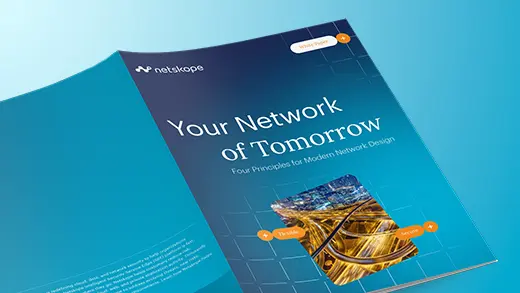

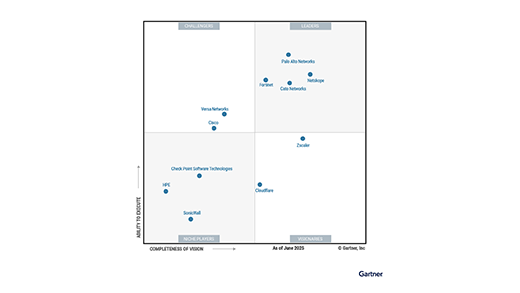
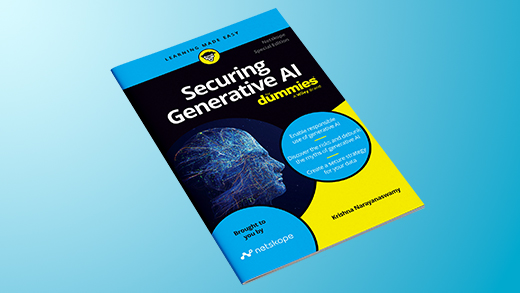

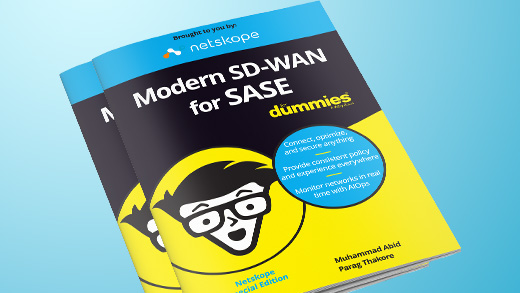

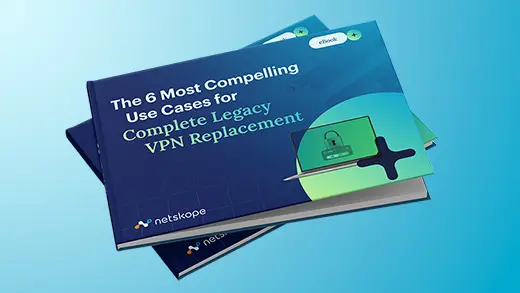

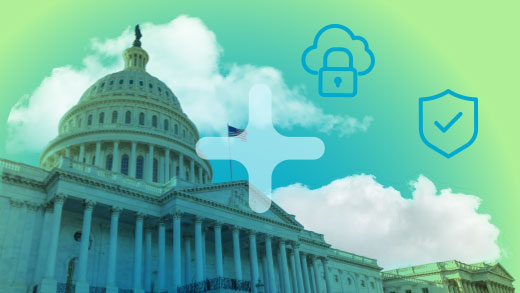








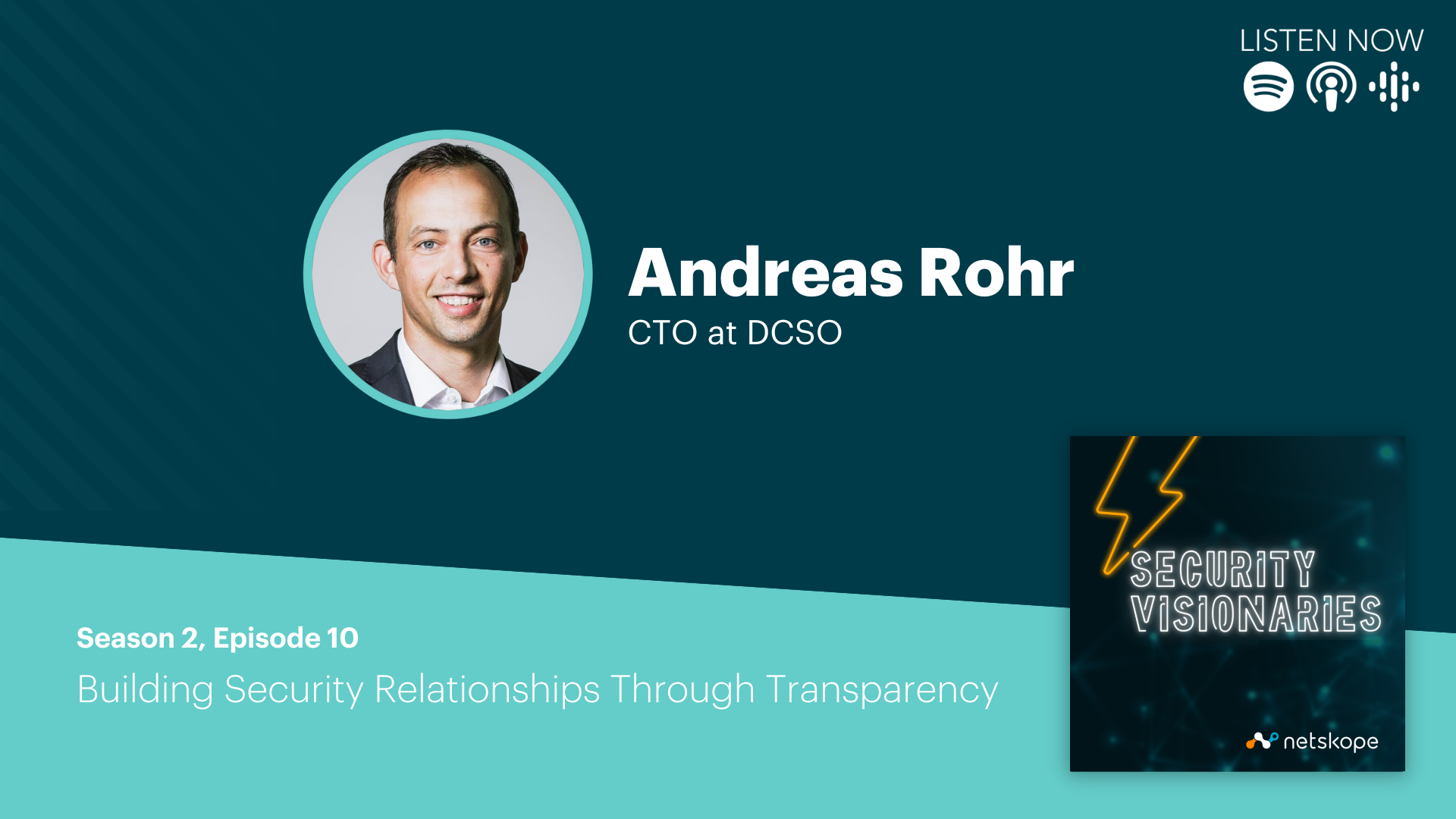
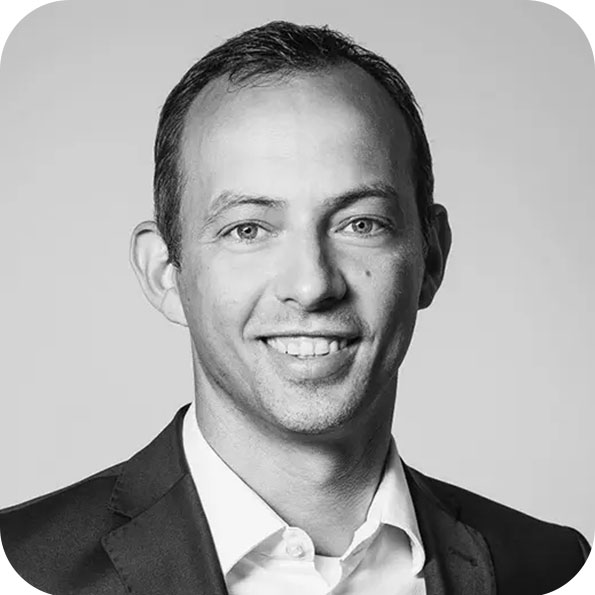


)
